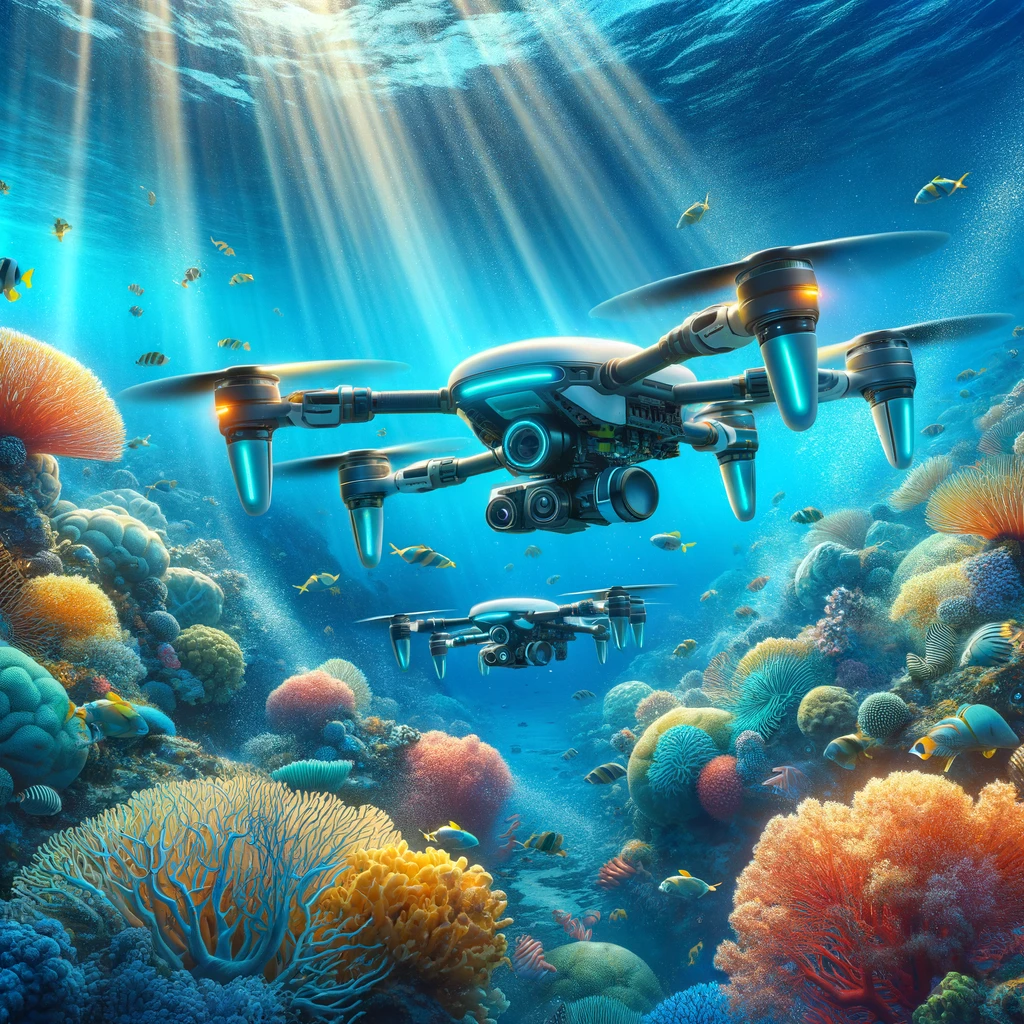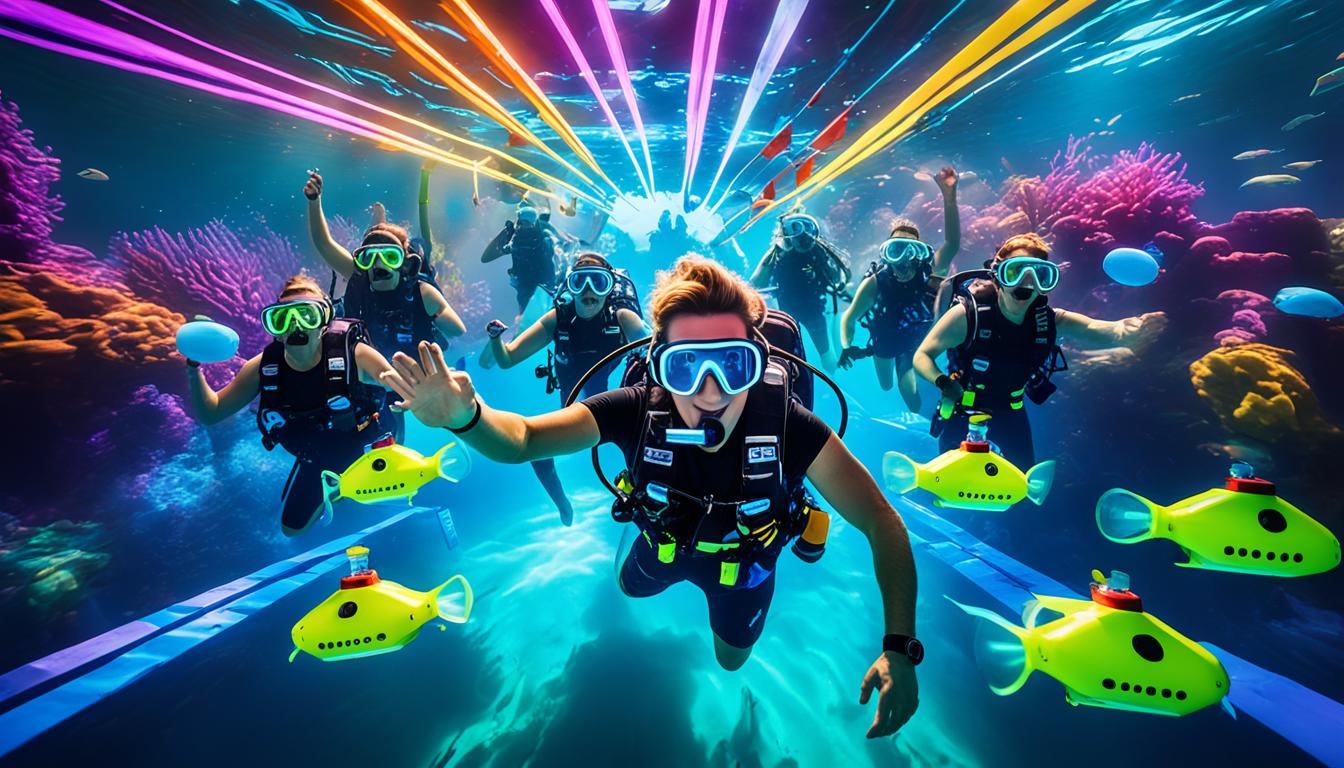Key Takeaways
- The PowerRay Wizard and Gladius Mini are both advanced underwater drones designed for exploration.
- Key specifications include differences in weight, battery life, and maximum depth capabilities.
- Camera quality is a critical factor, with both drones offering 4K resolution, but with varying camera features.
- Maneuverability and control are essential for navigating underwater, and each drone has its own system for ease of use.
- Battery life and additional features such as lighting and accessories can greatly influence the underwater experience.
Dive into the Depths: PowerRay Wizard and Gladius Mini
Imagine diving into the crystal-clear waters of the Caribbean, exploring a sunken shipwreck without getting wet. Underwater drones like the PowerRay Wizard and Gladius Mini make this possible. They are not just tools but gateways to adventure, revealing the mysteries of the deep. Let’s embark on a journey to discover which underwater drone might be your ticket to an unparalleled aquatic exploration.
Essential Specs: How They Measure Up
The PowerRay Wizard and the Gladius Mini are two of the most talked-about underwater drones, and for good reason. When choosing an underwater companion, it’s essential to understand how they stack up against each other. Weight plays a significant role in portability, with the PowerRay tipping the scales at approximately 8 lbs, while the Gladius Mini is lighter at around 4 lbs. This difference could be a deciding factor if you plan on trekking to remote dive sites.
Battery life is another crucial consideration. The PowerRay boasts a substantial 240-minute underwater adventure time, doubling the 120-minute lifespan of the Gladius Mini. When it comes to how deep they can dive, the PowerRay Wizard can explore up to 30 meters deep, while the Gladius Mini can reach down to 100 meters, offering a significant advantage for deeper explorations.
Both drones offer a tethered experience, ensuring you won’t lose your aquatic ally in the vast blue. They also share a top speed of 4 knots, ensuring swift movement through the currents. The tethered range for both is 100 meters, sufficient for most underwater escapades.
| Feature | PowerRay Wizard | Gladius Mini |
|---|---|---|
| Weight | ~8 lbs | ~4 lbs |
| Battery Life | 240 minutes | 120 minutes |
| Max Depth | 30 meters | 100 meters |
| Speed | 4 knots | 4 knots |
| Tethered Range | 100 meters | 100 meters |
Unleashing Potential: Key Features for Explorers
When you’re submerged in the underwater realm, the features of your drone become your lifeline to discovery. The PowerRay Wizard enchants with its sonar system, enabling you to locate fish and map underwater landscapes, a boon for fishermen and explorers alike. It also comes with a bait drop, which can lure aquatic life right to your camera lens.
The Gladius Mini, on the other hand, impresses with its five-thruster design for advanced stability and a 45-degree adjustable tilt-lock mode. This allows for smooth and controlled ascents, descents, and angular shots, essential for capturing dynamic footage. Both drones are equipped with LED lights to brighten the darkest underwater scenes, ensuring your visibility never falters.
But that’s not all. The PowerRay can bring the underwater world to your eyes in real-time with VR goggles, enhancing the experience with immersive visuals. The Gladius Mini doesn’t have VR capabilities, but it makes up for it with its sleek design and portability, which is perfect for adventurers on the go.
Maneuverability and Control: Navigating Underwater Terrain
Control is the essence of any exploration, and underwater drones are no exception. The way you guide your drone through the mysteries of the ocean can make or break your experience. That’s where maneuverability and control come into play, and it’s vital to understand how the PowerRay Wizard and the Gladius Mini handle the underwater terrain.
Steering Through the Currents: Remote Handling
The PowerRay Wizard is controlled via a base station connected to a mobile device, which acts as the screen and controller. This setup gives you a familiar and intuitive way to navigate, much like playing a video game. It’s responsive and gives you the confidence to steer your drone even in the presence of strong underwater currents.
The Gladius Mini, with its game-like controller, also offers an engaging experience. Its five-thruster system provides excellent stability and precision, allowing for smooth and responsive movement in all directions. This level of control is particularly useful when you’re trying to capture that perfect underwater shot or navigate through tight spaces.
Depth Diving: Stability at Various Depths
Depth can affect a drone’s performance, but the Gladius Mini’s 45-degree tilt-lock capability ensures it remains stable even when diving down to 100 meters. This feature is particularly handy when you’re capturing footage at an angle, as it maintains the camera’s orientation for consistent results.
The PowerRay, while it doesn’t dive as deep, still holds its own with a reliable stabilization system. Its ability to dive up to 30 meters means it’s more than capable for most recreational underwater explorers, and it maintains its poise even when conditions get a bit rough.
Endurance and Battery Life: Sustaining Underwater Exploration
Underwater exploration is not a sprint; it’s a marathon. And in this marathon, endurance is key. The battery life of your underwater drone determines how long you can explore before needing to resurface. Let’s see how the PowerRay Wizard and Gladius Mini stack up in the endurance department.
Underwater Marathon: Who Lasts Longer?
The PowerRay Wizard’s impressive 240-minute battery life is a testament to its endurance. It means you can spend a whole afternoon exploring without worrying about running out of power. This is especially useful if you’re using the drone for activities like fishing, where patience is as important as precision.
The Gladius Mini, while offering a shorter 120-minute battery life, still provides ample time for most dive sessions. Its quicker charge time can also be a benefit if you’re on a tight schedule and need to get back in the water quickly.
Quick Charge vs. Extended Excursions: Assessing Battery Options
Choosing between quick charge and extended battery life depends on your exploration style. If you’re someone who likes to take your time and soak in every detail, the PowerRay’s longer battery life is a clear winner. However, if you prefer multiple, shorter dives with less waiting in between, the Gladius Mini’s quick charge feature will be more up your alley.
- PowerRay Wizard: Longer dives with up to 4 hours of battery life.
- Gladius Mini: Shorter, more frequent dives with faster recharge times.
Remember, battery life also depends on how you use the drone. If you’re constantly on the move and using all the features, you’ll drain the battery faster. So, plan your dives accordingly and always keep an eye on the power indicator.
Accessorize the Adventure: Add-ons and Upgrade Potential
Accessories can greatly enhance your underwater drone experience, whether it’s by expanding the capabilities of your drone or by adding an element of fun to your exploration.
Bait Drop and Sonar: Fishing with PowerRay Wizard
The PowerRay Wizard comes with a unique feature for anglers – a bait drop. This allows you to deliver bait to a specific location and attract fish right to your drone. Combine this with the PowerRay’s sonar system, and you’ve got a powerful tool for locating and luring your next big catch.
Moreover, the sonar system can also map the underwater landscape, which is invaluable for divers looking to understand the terrain before taking the plunge. This dual functionality makes the PowerRay Wizard a versatile companion for a variety of underwater activities.
Tilt-Lock and Game Control: Enhancements on Gladius Mini
The Gladius Mini’s tilt-lock feature gives you the ability to capture stable footage at angles that other drones might struggle with. This can be the difference between a good underwater video and a great one. The game-like control system is not only fun but also provides a level of precision that’s appreciated when navigating through complex underwater environments.
Both drones offer LED lighting to illuminate the dark depths of the ocean, ensuring that your underwater journey is always well lit. Whether you’re exploring a coral reef or a sunken ship, these lights are essential for capturing the vibrant colors and hidden details of the deep.
Pros and Cons: Balancing the Scales
When deciding between the PowerRay Wizard and the Gladius Mini, it’s crucial to weigh the advantages and disadvantages of each. The PowerRay Wizard’s longer battery life and bait drop feature are major plus points for those looking to combine fishing with their underwater exploration. Its VR capabilities offer an immersive experience, allowing you to dive into the ocean’s depths from the comfort of your boat or shore.
The Gladius Mini, however, shines with its deeper diving capacity and lighter weight, making it a better choice for travelers and those interested in deep-sea exploration. Its tilt-lock feature and responsive controls also make it a favorite for capturing high-quality, stable footage.
Investment and Returns: Evaluating Price Points
When investing in an underwater drone, consider the return you’re expecting on your investment. The PowerRay Wizard, with its array of features tailored towards an immersive experience and utility for fishing, may offer a higher initial cost but also a richer set of capabilities. On the other hand, the Gladius Mini, with its portability and deep diving abilities, might be a more cost-effective option for those primarily interested in underwater photography and videography.
In terms of actual numbers, you can expect to invest anywhere from $1,000 to $1,500 for a PowerRay Wizard, while the Gladius Mini might set you back around $1,000 to $1,200. Prices can fluctuate based on additional accessories or specific retailer deals, so it’s always a good idea to shop around.
Frequently Asked Questions (FAQ)
It’s natural to have questions when considering a high-tech piece of equipment like an underwater drone. Let’s dive into some of the most common inquiries about the PowerRay Wizard and the Gladius Mini.
Can the PowerRay Wizard and Gladius Mini Stream Live Footage?
Yes, both the PowerRay Wizard and the Gladius Mini can stream live footage. The PowerRay Wizard enhances this capability with its VR goggles, providing an immersive first-person view. The Gladius Mini streams directly to your mobile device, allowing you to see what the drone sees in real-time.
Streaming live footage is a game-changer for those who want to share their underwater adventures with others or for professionals who need to make real-time decisions based on the visual data they’re receiving.
How Do These Drones Perform in Saltwater Environments?
Both drones are designed to handle saltwater environments, with corrosion-resistant materials that can withstand the ocean’s harsh conditions. However, it’s always recommended to rinse your drone with fresh water after each saltwater use to prolong its lifespan and maintain its performance.
What are the Warranty Periods for PowerRay Wizard and Gladius Mini?
The PowerRay Wizard typically comes with a one-year warranty, giving you peace of mind for your investment. The Gladius Mini also offers a one-year warranty, ensuring that any defects or issues that arise can be addressed by the manufacturer.
Always check the warranty details at the time of purchase, as terms can vary depending on the retailer or any additional coverage you may opt for.
Are These Drones Suitable for Professional Marine Research?
Both the PowerRay Wizard and the Gladius Mini have features that make them suitable for professional marine research. The PowerRay’s sonar capability and bait drop can be particularly useful for studying fish behavior, while the Gladius Mini’s deep diving ability and stable footage are excellent for surveying underwater ecosystems.
However, for more extensive scientific research, there may be more specialized equipment that would be better suited to specific tasks. It’s important to assess the requirements of your research before making a decision.
How User-Friendly are PowerRay Wizard and Gladius Mini for Beginners?
The PowerRay Wizard and Gladius Mini are both designed with user-friendliness in mind. They come with intuitive controls and user interfaces that make them accessible even for beginners. The PowerRay Wizard’s VR capabilities and mobile device integration, along with the Gladius Mini’s game-like controller, ensure that even those new to underwater drones can start exploring with ease.
Both drones also have active online communities and support resources to help new users get the most out of their underwater adventures. It’s always a good idea to start with calm, shallow waters and progressively move to more complex environments as you gain confidence and experience with your drone.







